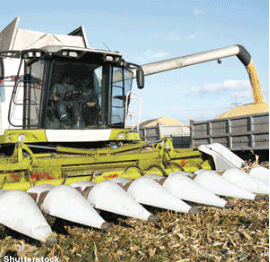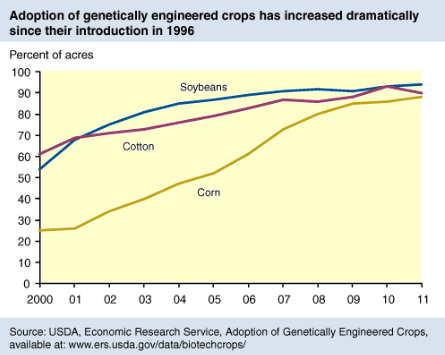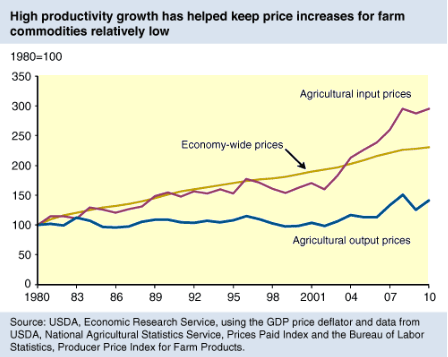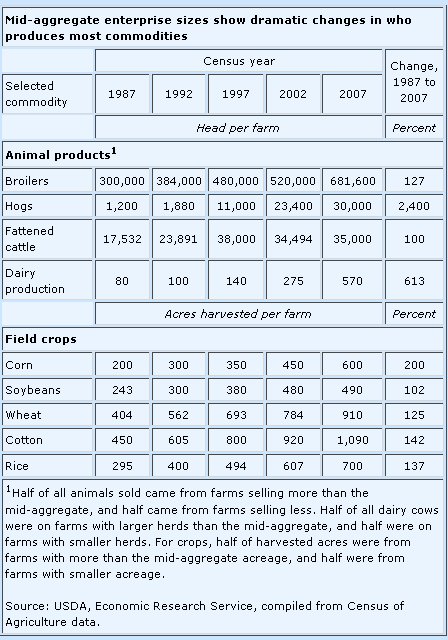



Changing Farming Practices Accompany Major Shifts in Farm Structure
Changing production practices, including adoption of labour-saving innovations, have contributed to and been affected by increases in both agricultural productivity and the concentration of production, write Erik O'Donoghue, James MacDonald, Utpal Vasavada and Patrick Sullivan of USDA Economic Research service in the latest issue of Amber Waves.For the past three decades, the number of US farms has remained fairly stable at about 2.2 million, while the amount of farmland declined about eight per cent between 1982 and 2007. However, this relative stability masks major shifts in the distribution of production and significant growth in the amount of goods and services produced by the agricultural sector.
The number of very large farms (those with over $500,000 in inflation-adjusted annual sales) has grown (see box, “Concentration of Agricultural Production Has Increased Since 1987”). Large farms’ share of agricultural production has increased, while the number and market share of all other farms except for the smallest (those with annual sales under $10,000) has declined.
 |
|
At the same time, US agricultural output has continued to grow rapidly, even as the amount of land and labour devoted to farming has declined (see “Is US Agricultural Productivity Growth Slowing?” in the September 2010 issue of Amber Waves). In response to changing market conditions, technologies, public policies, and a host of other factors, farmers, particularly those operating larger commercial-sized farms, have adjusted production practices in numerous ways to remain competitive.
US agriculture provides food and fibre for growing domestic and international markets, supplies the feedstock for an expanding bioenergy sector, and provides ecosystem services such as carbon sequestration to a nation increasingly concerned with the environment. Without the productivity growth embodied in more advanced farming practices, meeting the increased demand for agricultural goods and services would require expanded use of marginal land, thereby raising the cost of agricultural production, both in terms of market prices and environmental degradation.
Nonetheless, changing farming practices can have both positive and negative effects. For example, the introduction of genetically engineered (GE; or genetically modified, GM) seeds, wider adoption of irrigation, and growth in contract sales have allowed farm operators to diminish the intensity of soil tillage, reduce weather-related risks, and lower production costs through increased specialization. But widespread adoption of GE plants is viewed with concern by some consumers, by farmers experiencing weed resistance to herbicides, and by nearby farmers specializing in organic crop production. Wider adoption of irrigation can reduce the availability of water for other uses and has implications for pesticide and fertilizer runoff. Increased contracting can leave some farmers worried about price fixing and can increase their risk if the contractor defaults. Moreover, the geographic consolidation of larger livestock operations has heightened localised concerns about the handling of manure and its environmental consequences.
Changing Practices Contribute to Larger Farms, Greater Use of Production Contracts
The increasing dominance of confined animal feeding operations for many types of livestock and a growing reliance on production contracts have contributed to the growth of large, specialised poultry, hog, and dairy operations. While confined animal operations are not new, their use in livestock farming has been increasing. Changes in the relative prices of land, labour and capital over the past three decades may have encouraged the substitution of cheaper capital (in the form of more mechanized animal housing, feeding and manure management facilities) for more expensive land and labour. Furthermore, capital-intensive operations often find that increases in farm size can lower the cost of production per animal, leading to consolidation of production on larger operations. In contrast, the labour and management requirements of operations that raise animals under less confined conditions limit the potential growth of such operations.
Historically, most agricultural products have been bought and sold for immediate delivery (through ‘spot markets’) but a growing share of US farm output is produced and sold under agricultural contracts that govern how and when commodities change hands. In 2008, contracts covered nearly 40 per cent of the total value of agricultural production, up from 11 per cent in 1969. Production contracts (where the contractor owns the commodity and pays the farm operator to raise it) are widely used in livestock production, while marketing contracts (where the farmer retains ownership of the commodity but promises future delivery to the contractor) are used for many crops.
Product differentiation, quality control and the need to ensure a ready supply for processing facilities are key reasons why contractors prefer production and marketing contracts over spot markets. Production contracts are particularly prevalent in the poultry and hog sectors, accounting for 90 and 68 per cent of production, respectively, in 2008.
Producers also enjoy multiple benefits from using contracts. Contracts allow them to focus on one production stage while not having to worry about other aspects of the agribusiness, such as marketing or feed formulation. This frees farm labour, enabling producers to increase production of the contracted commodity (that is, grow in size) or to diversify by growing other commodities or pursuing off-farm work. Moreover, producers with contracts enjoy better access to capital markets, allowing them to carry more debt – and therefore more capital – given their net worth than producers without contracts. Additionally, contracts ensure an outlet for their product and reduce or eliminate price risk for both the farm’s output and for farm inputs provided by the contractor.
Changes in marketing arrangements, like other technological developments, have had a pronounced impact on farm sector productivity and structure. By reducing price risk, rewarding contract farmers for increasing production efficiency, and allowing farmers to become more specialized, contract sales have encouraged increased capital investments on large farms and further consolidation of production. Depending on the terms of the contract, they can also encourage the adoption of certain farming practices (for example, by requiring more stringent food safety practices) and require that housing and equipment meet minimum specifications, thereby weeding out less efficient operators over time.
One example of the impact of production contracts on efficiency is the increasing feed conversion rate among hog producers. The average quantity of feed required per hundredweight of gain declined 44 per cent for feeder-to-finish hog operations between 1992 and 2004. Most feeder-to-finish operations operate under production contracts. Since contractors typically bear the cost of supplying feeder pigs and feed to the farming operation, they have a strong incentive to invest in genetic improvements in the animals and improved formulations to reduce feed costs. And since contracts allow farmers to specialize in the grow-out phase of the production process, they have adopted practices that further increase feed efficiency, such as grouping pigs by age and weight so feed rations can be formulated for each pig’s specific needs. In contrast, the average feed conversion rate on farrow-to-finish hog operations – which are less likely to have production contracts and are less specialized – declined by only 15 per cent in 1992-2004.
While production contracts have boosted the productivity of livestock producers, they also limit a farm operator’s management options and can leave farmers who are heavily invested in specialized housing and equipment dependent on a single buyer. The concentration of market power in the hands of one or two contractors – particularly for products with a short shelf-life or a limited geographic market – can handicap farmers in negotiations and magnify their risk from contractor default. And while feed conversion efficiency has reduced the amount of waste produced by each animal, the geographic concentration of production encouraged by contracts may have led to localised and intensified environmental risks in specific areas.

Labour-Saving Innovations Help Crop Farmers Expand Their Operations
While agricultural contracts are less prevalent among crop farms, they are very important for specific commodities, such as sugar beet, tobacco and peanuts, and their use has increased over time for most other commodities. When contracts are used in crop farming, they are almost always marketing contracts used by larger operations. But aside from their long-term impacts through reduced price risk, crop marketing contracts do not appear to provide the same push toward concentration that has occurred in the poultry and hog industries. To the extent that management time prevents crop farm operators from expanding their operations, other technological advances (such as improved equipment) that reduce management requirements can ease this constraint, enabling farmers to expand and consolidate.
Improved farm equipment has enabled farmers to increase the size of their crop farms. For example, in 1970, an operator could plant 40 acres of row crops and harvest 4,000 bushels per day. By 2005, a producer could plant 420 acres and harvest 30,000 bushels in a single day. Consolidation trends have continued through the adoption of further labour-saving innovations, such as GE seed varieties, which have improved the efficiency of crop farm management.
GE crops were introduced in 1996 and have been widely adopted by producers. GE crops include herbicide-tolerant (HT) crops and insect-resistant (Bt) crops. HT crops were developed to survive specific herbicides, particularly glyphosate, that previously would have destroyed the crop along with the targeted weeds. Insect-resistant crops contain the gene from the soil bacterium Bt (Bacillus thuringiensis) that produces a protein toxic to specific insects, protecting the plant from insect damage. Based on USDA survey data, GE crops accounted for 94 per cent of US soybean acreage, 90 per cent of US cotton acreage and 88 per cent of US corn acreage in 2011.

According to ERS research, US farmers are realizing economic benefits from adopting GE crops, including lower pesticide costs, savings in management time and, in many cases, higher yields through reduced losses to pests. And to the extent that GE crops lower the cost of production and increase yields, they put downward pressure on crop prices, which, over time, forces out the least efficient producers, encouraging further consolidation of farming resources and concentration of production.
The impacts of GE crops vary with the crop, technology, pest-infestation levels, and other factors. Overall pesticide use and/or pesticide toxicity is lower for adopters of GE crops, and the adoption of herbicide-tolerant crops may also indirectly benefit the environment by encouraging the adoption of less intensive tillage (how farmers prepare their soil for seeding and weed/pest control) practices. However, weed resistance to glyphosate has become a problem in some areas, particularly the South, and some contend that GE crops are not safe to eat (some European countries ban importation of GE commodities). Farmers marketing non-GE varieties also cite potential risks of ‘gene flow’ from nearby fields planted to GE crops.
Farmers have a number of tillage options, including ‘conventional’ or plough tillage and several types of ‘conservation’ tillage – such as mulch till, ridge till and no-till – that leave at least 30 per cent of the soil covered by crop residue. Conservation tillage – particularly no-till –decreases soil erosion, increases water retention, reduces chemical run-off, and can shrink the carbon footprint of agriculture by lowering on-farm energy use and sequestering carbon within the soil.
Adoption of conservation tillage and a corresponding decline in conventional tillage has been stimulated by the prospects of higher economic returns and by public policies and programmes promoting reduced tillage for its environmental benefits. As a result, conservation tillage has increased since 1989. Since this tillage option uses fewer resources to ready the land for planting, when coupled with herbicide-tolerant crops, the benefits of GE crops and conservation tillage reinforce each other. However, since conservation tillage does not eliminate pests, when coupled with non-GE crops, pesticide usage and management requirements may increase while potentially lowering crop yields.
Despite the benefits arising from the use of GE crops and conservation tillage, the concentration of production on larger crop farms still generates concerns about food safety, environmental degradation, and the structure of agriculture. This has created a demand for commodities produced using alternative production methods, such as organic farming (see box, “Growth of Organic Foods Markets”).
Impacts on Productivity, Commodity Prices and the Environment
The trend toward concentrated production on specialised operations, while a concern for some, has had economic benefits that should be weighed against potential costs. The changing farming practices discussed here, along with others such as wider use of irrigation and growing adoption of precision agriculture technologies have allowed the farm sector to increase total output by nearly 50 per cent over the past three decades, even as resources used in farming declined. These freed resources have been applied elsewhere, contributing to increased productivity throughout the economy. And consumers of farm products have benefited, too. Despite occasional price spikes and recent trends to the contrary, price increases for agricultural commodities have lagged far behind both economy-wide price increases and increases in prices of agricultural inputs over most of the last 30 years.

The combination of changes in farming practices, conservation programme funding, and other structural trends have also resulted in environmental benefits, at least relative to the environmental consequences of producing today’s output using the farming practices of the 1970s. Changes in practices like tillage and livestock feed efficiency, when coupled with efforts by farmers to improve nutrient and pest management (often with financial help from and prodding by various levels of government), have helped limit soil erosion and nutrient run-off. As a result, the environmental footprint for the average unit of agricultural output produced has shrunk.
| Concentration of Agricultural Production Has Increased Since 1987 Because of the large and growing number of small farms in the US that produce very little in a typical year, statistics on the average level of production per farm may not be very informative. For many commodities, the number of both very large and very small farms is growing – a fact obscured by relatively steady average production levels. A clearer picture of the increasing concentration of production on larger farms can be seen by looking at the farm size for which half of all acres harvested (or animals raised) are on larger farms and half are on smaller farms, referred to as the mid-aggregate enterprise size. For example, in 1987, half of all hogs were produced on farms that sold 1,200 head or more. By 2007, half of all hogs sold were from farms that produced 30,000 head or more – an increase of 2,400 per cent over 20 years. While the increasing concentration of hog production on larger farms may be an extreme example, increasing mid-aggregate sizes were also observed for other livestock and poultry products, all the major field crops, and many other commodities. |

| Growth of Organic Foods Markets Not all the recent trends in farming practices have contributed to a concentration of production on larger farming operations. Due in part to consumer demand for pesticide-free foods, markets for organic products have grown, providing a profitable niche for farms of all sizes. USDA’s organic regulations aim to ensure consumer confidence in the organic label and define organic agriculture as an ecological production system established to respond to site-specific conditions by integrating cultural, biological, and mechanical practices that foster cycling of resources, promote ecological balance, and conserve biodiversity. As a result, organic farming tends to be more labor intensive than conventional farming. While some larger farms produce organic products, thus far, organic production has been relatively more common among smaller farms whose operators consider themselves full-time farmers. Once available only in natural food stores and farmers’ markets, organic food has grown rapidly in terms of supply and demand over the past decade. By 2009, organic products accounted for over 3.5 percent of food sold for at-home consumption, with organic sales accounting for much higher percentages of specific commodities, particularly fruit and vegetables. Organic production and other alternatives, such as locally grown food markets, satisfy consumers who perceive these foods as healthier, fresher and produced sustainably on small farms. However, it does come at a higher price since GE crops and manufactured fertilizers, pesticides and other chemicals (including antibiotics for livestock) often do not qualify as organic, making pest, weed and disease control more difficult, time-consuming and costly. |
December 2011








